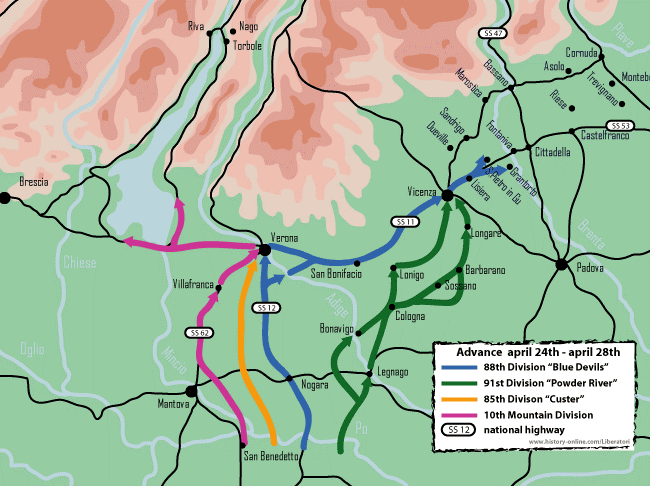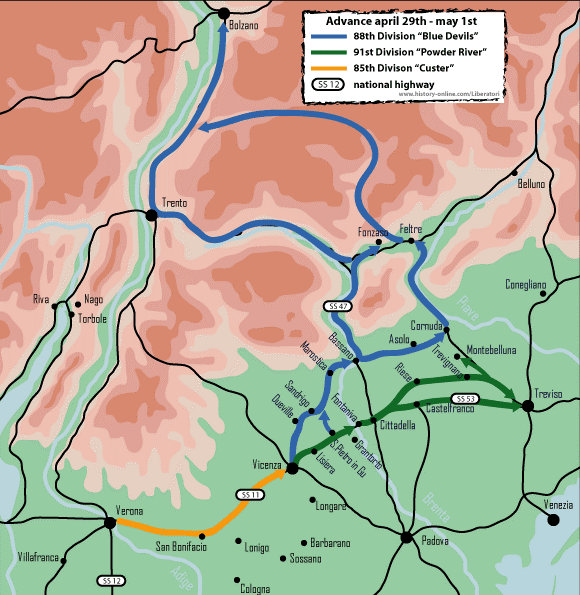Verona to Cornuda
The Allied advance from Verona to Cornuda
On April 1945, allied forces launched an offensive along the whole front and they succeeded in penetrating in the Po Valley. The territory finally favoured the Allies, particularly the 5th US Army that could exploit fully the rapidity of manoeuvre and action of the units.
In the Fifth Army, the II Corps had the task to pass the Po river and to go toward Verona , to stop the Germans escape way, toward the north, while the IV Corps had to go to the west.
The American divisions reached the banks of the great river around 24 April and they were ready to cross it. The greater parts of the bridges were destroyed and great quantities of German vehicles and materials layed on the ground, left by the escaping enemy.

from april 24th to 28th
From 24 April, the units crossed the river without meeting excessive resistance. From the departure points of San Benedetto Po, Ostiglia and Sermide the 10th mountain division on the left advanced toward Villafranca, to conquer the airport, the 88th divisions and 85th were directed toward Verona while the 91st division was protecting the right flank and maintaining the connection with the 8th British Army unites.
The 351st regiment of the 88th division, helped by supporting armored units, was the first unit to enter in Verona at midnight the 25th of April, engaging the enemy, surprised by the rapidity of the American advance, in an intense fight trough the city streets. The rest of the 88th division came in near Verona in early hours of 26 April.
The 10th mountain division, conquered Villafranca, and entered in Verona from the west, finding the city freed by the quick advancing of the 88th division “Blue Devils.”
On April 26, the three regiments of the 91st division “Powder River” crossed the Po River, positionining themselves in proximity of the Adige river near Legnago and Bonavigo, a town a bit more north of it. In the night between the 25th and 26th of April in Cerea, situated some kilometers west of Legnago, a violent clash developed between the 361st regiment of the 91st division and a German column that tried to penetrate the American lines and to move to the north.
The 88th division left Verona to go toward Vicenza, on the Highway 11. The 350th regiment, supported by the 752nd Tank Battalion Destroyer and by the 805th Tank Battalion, crossed the Adige river using a railway bridge and at 7:00 o’clock of 27 April, the whole regiment advanced along the road.
The other regiments crossed at south of Verona and the whole division advanced along the narrow passage made by the Highway 11. The 88th division was the spearhead of the American advance in the sector and the rapidity had the priority over the safety. Under these conditions, also experimented by other American units, it was frequent that the enemy stormed behind the lines, stopping the support units even for long and temporarily breaking the cohesion of the advance.
After San Bonifacio the division’s vanguard, constituted by a task force made of the 350th regiment, stopped at midnight in April 27, at 12 km from Vicenza, in order to move further at the early morning.
At the south of the Highway 11, the 91st division advanced protecting the right flank. At the sunrise of April 27, the 361st regiment crossed the river Adige in Bonavigo, while the 363rd advanced from Legnago. The 362nd regiment remained there to protect the crossing area of the river Adige.
In Orti, on the other bank of the river Adige, the Task Force George (a battalion of the 362nd regiment, the 755th Tank Battalion and the 805th Tank Battalion Destroyer) stirred toward Minerbe and reached Cologna in middle afternoon of April 27, advancing then up to Longare, conquered the morning after April 28.
On 27 April 22:00, the second battalion of the 361st regiment conquered Lonigo after a night combat against German forces. Other battalions gained positions near Lonigo, ready to advance the morning after. The 363rd regiment advanced along the path followed by the Task Force George a couple of hours before, encountering in the evening of April 27 with the enemy that tried to block the road near Sossano and the morning after in Barbarano, the very same place where the Task Force George engaged the enemy before. The 363rd regiment reached Debba the 23 April 28.
On April 28, the American units of the 88th and the 91st division entered in Vicenza . The Task Force of the 350th regiment, 88th division, was the first unit to enter the city. the partisans had already took the control of part of the urban area, but different small groups of Germans opposed a fanatical resistance. After 16:00 in the afternoon, the Task Force George, the 361st regiment, that had crossed the Berice hills, entered Vicenza from the south. The 363rd regiment reached Debba at 23:45.
In the meantime, the 85th division remained to protect the back areas of Verona, ready as a reserve. The 10th Mountain Division directed from Verona toward north along both banks of Lake Garda. The German forces in northern Italy, were desperately trying to move north and to reorganize a defence on the mountains. Although the end of the Third Reich was near and the magnificent advance of the Allied was a clear sign of the progressive collapse of the Nazi war machine, the German units never renounced to fight, engaging the Allied forces in continuous interdiction actions along the communications way or opposing strong resistance in to the city centres.
After the liberation of Vicenza the 88th divisions and 91st had to advance for maximizing the efforts made till then. The next obstacle was the Brenta river and the main target were Bassano, Cornuda, Feltre and the Brenner Pass. Cornuda was a target assigned to the 91st division, but the events would have modified the plans.

from april 29th to may 1st
The 350th regiment advanced toward San Pietro in Gu, conquering the town with the 1st and 3rd battalion, and Grantorto, occupied by the 2nd battalion, reaching these positions at the sunset of 28 April.
At 5:20 29 April, a violent German counterattack, conducted using captured Americans vehicles, pushed back the American units around St. Pietro in Gu, in the town center, where the attack was blocked. During this action, the Germans captured some American soldiers.
The 91st division in proximity of Fontaniva crossed the river Brenta. The operation was very difficult because of the ground strewn with mines and of the skirmishing organized by the enemy.
The Task Force George assured the ford on the Brenta that allowed the 361st regiment to go beyond it at 14:30 of April 29, assuming a defence position. At 12:00 the Task Force George quickly advanced passing through Fontaniva.
The 361st regiment advanced along the Highway 53 toward Treviso, conquering in the afternoon of April 29 Cittadella (3rd battalion) and Galliera (2nd battalion). At the sunset, the 3rd battalion reached the outskirts of Treviso, after an intense and confused fight along the Highway 53. The 363rd regiment moved from Debba, toward Treviso along a way shifted to north.
Rossano was freed by the 1st and 2nd battalion of the 363rd regiment at 06:00 30 April, later on Riese and Caselle were freed in the early afternoon. The 3rd battalion came for first to Trevignano in the afternoon.
The regiments of the 91st division rejoined around Treviso on 1 May. The division recognition troops were sent to Montebelluna, where groups of partisan communicated the intention of many Nazi officers to surrender. In the town, the Americans found 1300 Nazi officers and soldiers.
The resistance met along the Highway 53 by the 91st division had made the advance toward north of the 88th division necessary, in order to reach the Dolomites as soon as possible and to prevent the flow of German soldiers toward the north mountainous areas. Here the enemy could oppose a solid and dangerous defence and recreate the same difficult conditions incurred during the preceding months.
The 88th moved therefore toward Bassano. The 351st regiment reached the river Brenta’s banks in proximity of the city and the following day they crossed the river in forces. On 30 April, the 350th regiment was positioned in defence of the left side: Dueville was freed by the 2nd battalion, Sandrigo by the 3rd battalion and Marostica by the 1st battalion. In this way, the road between Bassano and Vicenza was insured and with the support of the partisan several nearby towns were freed.
The rapid 88th division columns were divided in Bassano to encircle the retiring German troops in a grip. The 351st regiment was directed along the Highway 47 in direction of Trento, while the 349th regiment went to conquer Cornuda. The 752nd Tank Battalion and the 805th Tank Battalion Destroyer operated in support of these two columns.
After the battle of Cornuda, the 2nd battalion of the 349th regiment entered in Feltre on May 1. In the meantime the 351st regiment met a determinate resistance in Fonzaso, encountering with a fanatical unit of the Hitler’s Youth. After this episode, the regiment reached Borgo Valsugana.
On 2 May, the 349th regiment reached at midday Fiera di Primiero. The news of Germans army surrender in Italy was notified through the German prisoners before official sources and only on 3 May all the combat units were informed.
According to new command orders, the new target for the whole division was Innsbruck in Austria. The 88th division, the 349th regiment in detail, was the first Allied unit to join the Mediterranean front to the European front, estabilishing a link with the 103rd US division coming from Bavaria at the Brenner pass. This happened at 10:51, 4 May 1945 .
After the German surrender, the area around Cornuda was under the control of the 338th regiment, 85th division “Custer”
The “Blue Devils” of the 88th division performed other important actions, recovering 23 tons of gold from the Bank of Italy steeled by the Germans in Rome, inestimable art collections stolen by nazi-fascist officials.
Near Bolzano Heinrich Himmler’s family, who perhaps was thinking to be held in a protected area, was captured. He was the head of the SS and inventor of the “final solution”, the Hebrews’ extermination.
In Merano the 349th regiment captured the whole staff of the Nazi propaganda radio called Radio Berlin, the Axis Sally’s propaganda broadcast radio, alias Mildred Elizabeth Sisk, an American born girl devoted to the Nazism. Axis Sally was a constant presence in the life of the American soldiers, she tried to weaken the moral of the soldiers and to convince them to desert, but perhaps more than to demoralize them she exasperated the GIs making them bolder and determinated to successfully end the war, as soon as possible. This detail is particularly curious: it was Axis Sally the first to call the 88th division “Blue Devils” (blue like the colour of the division’s sign) as a depreciative title, but the soldiers liked the nickname and officially adopted it.